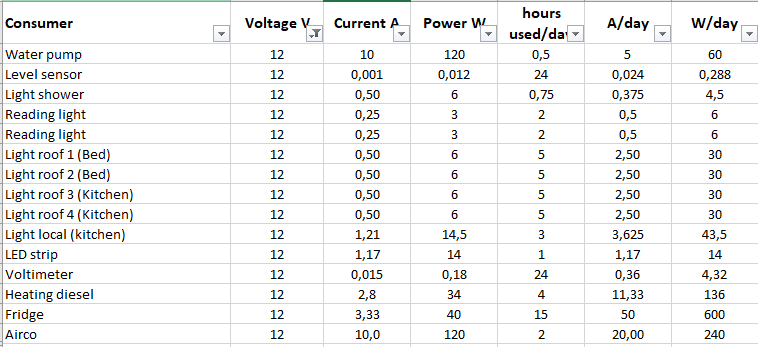Hi all! :-)
I am a young an enthousiast girl buzy with a camperitzation of a van (not sure how far I will get but I'll try!) and I saw and read a lot of information, but I have some doubts about which criteria to follow when choosing Victron equipment. Hopefully someone can help me! My apologies upfront if I'm asking stupid questions :(
My system will have:
- 2x320W solar panels
- 2x170 Ah 12 V batteries (link 1 or link 2, to be decided) --> are these ok for the application?
- 1x Relay RL-180/200 12 V to connect to the alternator
- 1x SmartSolar charge controller 100/30 (because max current both panels is 21 A)
But I am not able to define what are the specs that I need for the:
- Multiplus inverter/charger from Victron:
First question is, do I want a module that does alltogether or shall I buy separate components? Second question: which is the power that I need for the charger and inverter side?
My consumers in 230 V are:

Total A/day = 23,73; Total W/day = 5458
My consumers in 12 V are:

Total A/day = 102,88; Total W/day = 1234,6
Third question is: I want to install an outer power take off to connect to the camping 230 V socket and charge/use the 230V consumers with the electricity of the camping mains. If I would connect the vehicle to the camping socket, will the multiplus inverter/charger charge the batteries and allow me to use my 230 V consumers at the same time? I want to avoid the situation of connecting to the camping grid, batteries not full and using 230 V consumers and not having enough power, since with a 10 A socket from the camping, I can only consume 2300 W (3680 W max with 16 A). Like: I plug to the camping socket and I plug my hairdryer, does the inverter charge at the same time the auxiliary batteries? If so, with a 12/1600/70 model and a 1000 W hair dryer, I could not connect many more things since the inverter can deliver max 1300 W!
Is the 12/1600/70 indicating the max charging current of the battery? What is the maximum charging current of the batteries? 170 A?
Also not able to define which:
- battery smart protect: fourth question: which of these 65A/100A/220A ? or another?
Sorry for my lengthy email, but I am new in this field. Every help is very appreaciated!
Many thanks in advance,
Wendy


